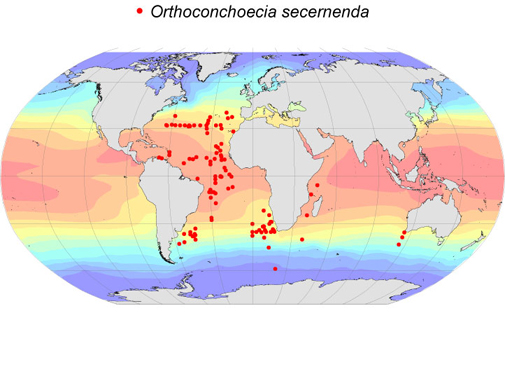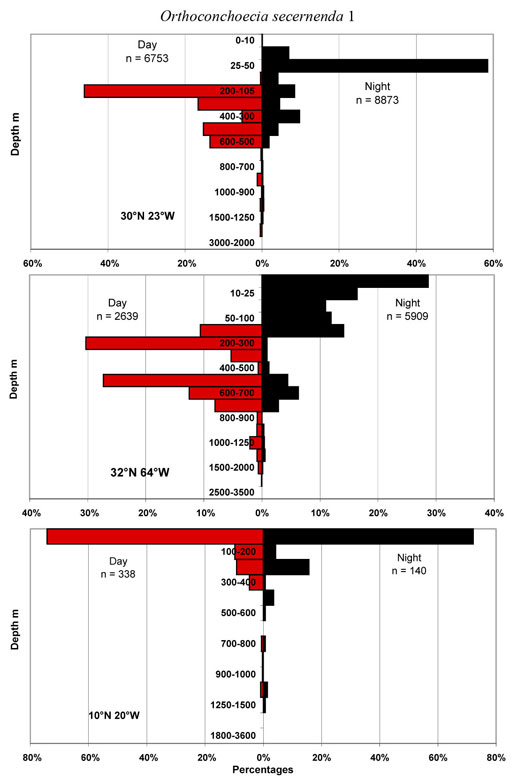Notes
340 records
This species was described by Vavra (1906) as a large sibling of Conchoecia bispinosa, but Müller (1906) immediately synonymized it with C. bispinosa, and so it was ignored until Angel (1971) re-described it. He showed that despite its close similarity to C. bispinosa live specimens can easily distinguished by being more intensely pigmented and the juveniles having distinctively larger shoulder vaults. Angel also retained it as a Conchoecia species, but soon after Poulsen (1973) re-classified it in Granata and Caporiacco’s (1949) genus Orthoconchoecia. Martens (1979) designated O. striola as the type species, which is unfortunate since this species does not occur in the Atlantic from where all Granata and Caporiacco’s material came. Moreover, there are at least two sizes of ‘O. striola’ in the Pacific. The range of O. secernenda in the Atlantic is from 40°N to 52°S. There is a single record from 59°S, which is dubious. Superficially this species is quite similar to striola but lacks the strong horizontal striations seen in the type species for the genus. It is a mesopelagic species that undertakes diel vertical migrations; juveniles occur sporadically in the neuston.
| Equator
|
n
|
Mean mm
|
s.d.
|
Range mm
|
|---|
| Female
|
21
|
2.50
|
0.083
|
2.34-2.64
|
|---|
| Male
|
2
|
|
|
2.24
|
|---|
| A-1
|
44
|
1.57
|
0.039
|
1.46-1.64
|
|---|
| A-2
|
21
|
1.00
|
0.025
|
0.96-1.04
|
|---|
| A-3
|
41
|
0.70
|
0.015
|
0.66-0.72
|
|---|
| Bermuda
|
n
|
Mean mm
|
s.d.
|
Range mm
|
|---|
| Female
|
204
|
2.71
|
0.103
|
2.40-3.04
|
|---|
| Male
|
207
|
2.40
|
0.071
|
2.20-2.56 (2.72)
|
|---|
| A-1
|
215
|
1.71
|
0.072
|
(1.40)1.54-1.90
|
|---|
| A-2
|
216
|
1.11
|
0.046
|
0.94-1.26
|
|---|
| A-3
|
216
|
0.76
|
0.036
|
0.68-0.88
|
|---|
| A-4
|
204
|
2.71
|
0.103
|
2.40-3.04
|
|---|
| Azores Front
|
n
|
Mean mm
|
s.d.
|
Range mm
|
|---|
| Female
|
10
|
2.39
|
0.112
|
2.22-2.60
|
|---|
| Male
|
2
|
2.19
|
0.050
|
2.14-2.24
|
|---|
| A-1
|
18
|
1.55
|
0.052
|
1.46-1.62
|
|---|
| A-2
|
21
|
1.01
|
0.074
|
0.94-1.22
|
|---|
| A-3
|
|
|
|
|
|---|





